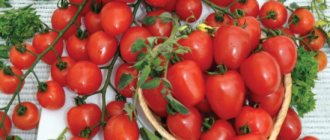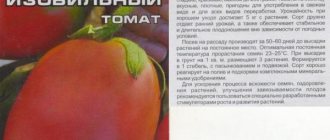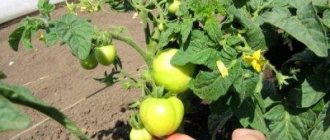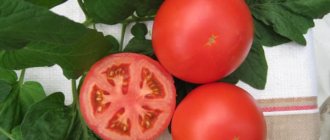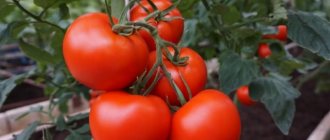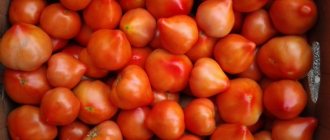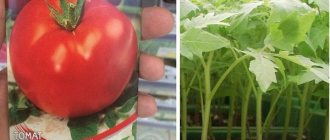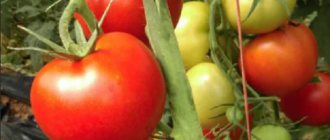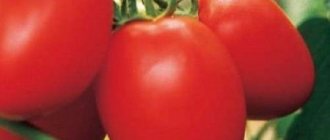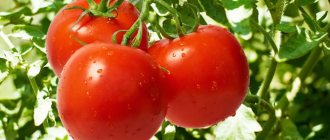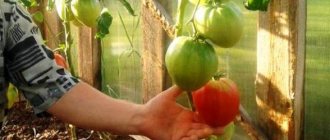Description of tomato variety Cornabel
The Cornabel F1 tomato is a hybrid bred by French specialists from the Vilmorin company. Although this tomato is grown in Russia, it is not yet included in the State Register. Some sources identify this tomato with the Dulce variety of the same originator. It should be kept in mind that these are completely different tomato hybrids.
Kornabel belongs to the mid-season varieties - 60 days pass from the moment of planting seedlings to harvesting (and 110–115 days from the moment of emergence of seedlings). Suitable for cultivation both in open ground and greenhouse conditions, therefore it can be grown throughout Russia.
Distinctive features
A distinctive feature is not only the shape of the tomato, but also its belonging to indeterminate varieties. These are varieties that grow continuously throughout the season. Since the bushes grow tall, they need to be shaped and tied up.
Features of the Cornabel tomato
The Cornabel hybrid has a number of advantages:
- one-dimensionality of fruits;
- long-term preservation of seed germination (5–6 years);
- extended fruiting period;
- excellent ability to set fruit even under unfavorable weather conditions;
- good pulp density, ensuring high transportability;
- resistance to most tomato diseases (tobacco mosaic virus, verticillium and fusarium);
- excellent taste.
The disadvantages include the relative complexity of agricultural technology, as well as the high cost of seeds.
Given the huge number of varieties and hybrids of tomatoes, it is very difficult to compare Cornabel with other tomatoes.
Comparison of the Cornabel hybrid with some mid-season indeterminate tomatoes - table
| Variety name | Ripening time, days | Height, cm | Fruit weight, g | Productivity | Peculiarities |
| Kornabel F1 | 110–115 | Up to 200 | 180–200 | 5–7 kg from 1 bush | Good fruit formation in bad weather conditions |
| 33 heroes | 110–115 | Up to 150 | 150–400 | Up to 10 kg per 1m2 | Drought resistance |
| Concorde F1 | 90–100 | Up to 150 | 210–230 | 5–6 kg from 1 bush | High resistance to TMV, verticillium, fusarium and cladosporiosis. |
| One hundred pounds | 110–115 | Up to 200 | 200–300 | Up to 10 kg per 1m2 | Particularly resistant to lack of heat and high humidity |
| Charisma F1 | 115–118 | Up to 150 | 170 | Up to 7 kg from 1 bush | Resistance to temperature changes and diseases |
Comparison of Grozdeva and Cornabel tomatoes on video
Appearance of tomato
Hybrid Cornabel F1 belongs to indeterminate (with continuous growth) tomatoes. This tomato is generative in type, that is, it has an increased ability to bear fruit and a weak ability to form stepsons. Powerful bushes with a developed root system have an open bush, due to which they are well ventilated.
Tomato Cornabel is distinguished by powerful bushes
The fruits are tied in clusters of 7 pieces. Tomatoes have an elongated, pointed shape, reminiscent of bell peppers. The fruits are quite large in size - up to 15 cm in length, with an average weight of 180–200 g (there are large specimens weighing 400–450 g, and at the end of the season “dwarfs” weighing 70–80 g). Ripe fruits have an even bright red color and a glossy surface.
Tomatoes are pepper-shaped and bright red in color.
The pulp is juicy and dense, with a very good sweet taste. A distinctive feature is the high dry matter content.
The fruits are very fleshy, the seed chambers occupy a small part of the fruit
Description of the bush
If you carefully look at the photo and description, it will become clear that the Cornabel hybrid belongs to the group of indeterminate tomatoes - its vine can grow indefinitely in length.
This tomato belongs to the group of generative hybrids - it is aimed at producing fruits and forms few stepsons. Cornabel has powerful roots and an open bush, thanks to which the plant is well ventilated.
Description of fruits
According to its taste characteristics, the hybrid is classified as a universal-use tomato. In fruits, the share of dry matter is at least 7%; this is a good distinguishing feature of Cornabel from other varieties and hybrids. The fruits of the hybrid are endowed with excellent taste and aroma. They can be eaten without cooking.
Cornabelle tomatoes have a fairly dense shell; they easily retain their shape after lying in vegetable boxes. Russian housewives willingly use fruits for canning in their entirety.
Basic qualities of fruits
The fruits are elongated (up to 15 cm), dense, red in color at maturity, weighing about 200 grams, juicy, fleshy, with good tomato taste. These tomatoes are great for both fresh consumption and canning. The skin does not crack, which is very important.
Advantages: excellent fruit set even in unfavorable conditions, high transportability, resistance to major tomato diseases. Excellent for growing high quality products.
Productivity of Cornabelle tomato: over 5 kg of fruit from 1 plant (subject to agricultural practices).
Taste qualities of fruits
In terms of its taste, the Cornabel tomato is considered a universal variety. Dry matter in fruits contains about 7%. Tomatoes have excellent taste and aroma, so they can be eaten without any cooking. Also, their taste is perfectly revealed in salads.
The fruits retain their shape well, thanks to their dense skin, look original, are easily placed in any container and are also easy to remove, which is why many people use them for canning in their entirety. Cornabelle F1 tomatoes are also ideal for drying.
Area of application of fruits
Universal tomatoes - great for fresh consumption. They have a pleasant taste, they are used in salads and slices, as well as for preparing various dishes and preparations:
- sauces;
- tomato juice;
- Sun-dried tomatoes;
- lecho;
- canning in its entirety.
Cornabelle tomatoes are well suited for drying
Advantages and disadvantages
The positive qualities include the following characteristics of the Cornabel tomato:
- excellent taste of the fruit;
- long fruiting period;
- versatility of using vegetables;
- good keeping quality and transportability;
- high yields.
Negative qualities include the need to tie up bushes and the high cost of seed material.
Note! Kornabel F1 is a hybrid, so there is no point in preparing the seeds yourself. They will not have the qualities stated in the characteristics.
Optimal growing conditions
The Cornabel variety is suitable for cultivation in any climate zone. In the southern regions, tomatoes can be grown in open ground, in the middle and northern latitudes - in greenhouses.
Tomato is a very heat-loving plant, so it feels comfortable at this soil temperature:
- during the day – 20-22 °C;
- at night – 16-18 °C.
At temperatures lower than 16 °C, the absorption of phosphorus and nitrogen deteriorates, and the development of the adventitious root system stops. As a result, access to water is limited. At temperatures below 10-12 °C, the roots completely stop absorbing nutrients and the growth of the tomato stops.
Optimal timing for cultivation
It is better to plan sowing of tomato grains for seedlings at the end of February - beginning of March, depending on the climatic characteristics of the cultivation region. It is important that before transplanting to a permanent location, the stems become stronger and develop strong roots. To do this they will need at least 60 days.
Please note that indeterminate hybrids need to be sown several weeks earlier than other varieties. However, seedlings should not be allowed to overgrow. The seedlings must be in an open area before they begin to flower. Otherwise, they will not take root or will be stunted.
When growing Cornabel in greenhouses, the sowing time depends on the material and features of the covering structures. For example, in heated structures, tomatoes should be planted at the end of April. But in greenhouses that are equipped with an additional internal covering layer of polyethylene, it is better to do this in the first ten days of May. The same deadlines should be observed when you plan to plant tomatoes in a polycarbonate greenhouse. If there is no additional shelter or heating units in the room, it is better to start planting seedlings after the 20th of May.
Equally important is the condition of the soil, as well as the air temperature in the greenhouse. Ideally, the substrate should be heated to a stable +15°C, and the air to +20°C.
Regardless of the place and method of growing the hybrid, in the fall you need to prepare the soil, enriching it with the main nutritional components (nitrogen, phosphorus, potassium).
Did you know? Monuments to tomatoes have been erected in the Ukrainian cities of Kamenka-Dneprovskaya and Tsyuryupinsk.
History of variety selection
The authorship of pepper tomatoes belongs to the famous French breeders. In 2003, their efforts were crowned with success. The new variety really pleasantly surprised consumers not only with its appearance, but also with its taste characteristics. Vegetable growers appreciated the undemanding nature of the hybrid when growing, its high yield and uniform fruit size.
The variety can be cultivated both in a greenhouse and in open ground. It does not develop well in regions with cold climates, since it is oriented towards southern latitudes. In temperate climates, this variety of nightshade is best grown in covered structures.
Agricultural technology tomato Cornabel F1
The agricultural technology for growing the Cornabel tomato is determined by its main characteristics, in particular, its belonging to indeterminate varieties. This hybrid requires constant formation of the bush and tying it to a support. Planting seeds directly into the ground is possible only in very warm climatic regions. Therefore, the most common way to cultivate tomatoes is to grow them through seedlings.
Growing seedlings
It is recommended to sow seeds for seedlings 50-60 days before the intended planting in open ground. The approximate start date for planting is the end of February or the beginning of March. If you plan to grow Cornabel tomatoes in a greenhouse, you can start preparing seedlings a little earlier.
Advice! It is necessary to add organic matter (peat, compost, humus) and mineral fertilizers (phosphorus, nitrogen, potassium) to the soil prepared for sowing seeds.
It is recommended to pick seedlings into separate planting containers when the first pair of true leaves are formed. The key to a high yield is to provide space during the plant formation stage. An important step is to harden the seedlings by placing them in the open air. First for a short time. It should be gradually increased, leaving the seedlings in the open air for a day, immediately before planting in the ground.
Seed preparation
Since this is a first-generation hybrid variety, the seeds must be purchased in specialized stores. Before sowing, the seeds are soaked in water for 20 minutes. The floating seeds are removed, and the rest are used for sowing. You can keep the seeds in a weak solution of potassium permanganate for disinfection.
Before planting, the seeds are germinated a little. To do this, place soaked gauze or cotton wool in a plate, spread the seeds over it in a thin layer and cover with damp gauze. As soon as the seeds hatch, you can begin planting.
Planting seeds and planting seedlings
Tomatoes are grown by seedlings or without seedlings. Seeds are sown at the end of February, 1–1.5 g/m², in closed ground. Planting occurs at the end of May, according to the 70x50 cm pattern
It is important to ensure that tomatoes receive at least 10 hours of light per day.
Seeds are sown in cassettes or special seedling boxes. At a constant temperature of 20–22 °C, the first shoots of the variety appear on days 6–7. After the second pair of true leaves appears, the seedlings are picked and each plant is transplanted into a separate container. If planting is carried out in open ground, you need to make a shelter from polyethylene film and spunbond.
During the growth period, seedlings require constant feeding; mineral and organic fertilizers are used for this. When ready-made seedlings are planted in the field, it will not hurt to add complex fertilizers and rotted manure to the hole.
In order to increase the yield, it is necessary to change the location of the beds every year. It is better to do planting in good weather, as a sudden change in temperature can negatively affect the seedlings.
Rules for planting in the ground
Cornabelle tomato seedlings should be planted in a permanent place after the soil has completely warmed up. It is optimal to warm the soil to 15-20 °C to the depth of the future planting hole, on average about 10 cm. The timing of planting seedlings varies for different climatic zones. Approximately you can start planting in May, in greenhouses - 1-1.5 months earlier.
An important point is to follow the seedling planting pattern so that the roots of nearby plants do not get tangled. For proper and full development, the distance between seedlings should be at least 50-60 cm. Rows should be placed at a distance of 70-100 cm from each other. Thus, 2 bushes are placed per 1 m2.
Step-by-step planting of Cornabel tomatoes:
- Prepare planting holes about 15 cm deep.
- Each hole is spilled with water.
- The seedlings are carefully removed from the planting container and placed in the hole.
- The hole is covered with earth.
- About 1 liter of water is poured into each well.
Comment! Excessive pressing of the soil around planted seedlings can damage the root system.
Preparing the land for planting seedlings
Open beds, just like greenhouse ones, require preliminary preparation. To do this, in the fall, remove all remnants of predecessor plants from the selected area, after rain or heavy watering, distribute fertilizers and dig the soil deeply. Then use a rake to level it and compact it slightly.
For each square meter you will need to add up to 4 kg of compost or humus, as well as about 80 g of superphosphate, 1 kg of wood ash and at least 2 kg of high-moor peat.
Please note that fresh manure is strictly contraindicated in vegetable beds, as it attracts pathogenic microbes and pests. Caution will not be superfluous when using peat, because this component contributes to the oxidation of the soil. To eliminate these undesirable consequences, experienced gardeners advise adding a little dolomite flour to the nutrient mixture (for alkalization), and generously watering the manure with a 5% solution of copper sulfate before use.
We recommend reading when and how to plant tomato seedlings correctly: timing and planting technology. To clear the soil of harmful insects, it is better to dig just before frost. And with the onset of spring, the soil is loosened and smoothed with a rake.
Tomato seedlings are transplanted after waiting for stable heat, when the air warms up to +15...+19°C, and the ground - to +14°C. Just before the procedure, do not forget to clear the bed of emerging weeds and loosen the soil with a hoe.
Technology of planting seedlings
In the prepared area, you need to make holes up to 14-15 cm deep and water them generously. It is advisable to leave a space of half a meter between neighboring plants with row spacing of 60–100 cm.
Given the tendency of Cornabel F1 to grow unlimitedly, it is better to plant the hybrid in rows. This will make care easier and will also promote better ventilation of the root part of the stems. As a result, on every square meter of land you should get 2 bushes. Any larger quantity is unacceptable.
Peat pots with seedlings are placed in prepared moist holes and sprinkled with fresh soil. Over time, the material of the product will dissolve, giving its nutritional components to the tomato roots.
Important! An acidic environment is strictly contraindicated for tomatoes. In such areas, in the fall, to correct the acidity of the soil, it is necessary to add dolomite flour, lime, cement dust or old plaster (from 150 to 300 g/m²). If the seeds were sown in tablets, they will need to be carefully removed from the containers. Make sure that the soil completely covers the root collar.
Use of fruits
Traditionally, all elongated tomatoes are primarily grown whole for preservation.
Firstly, it is very convenient, because neat and compact fruits fit perfectly into any container for twists, easily passing through the neck, and are then just as conveniently removed; secondly, such preparations look extremely appetizing.
You will probably be interested in learning recipes for cooking tomatoes in their own juice and tomato jam.
Nevertheless, the fruits of this hybrid, due to their good taste, are well suited for salads, and it is also very good to eat this tomato whole right from the garden, as always, it is very aromatic and tasty.
Another traditional way to use tomatoes in their “cream” form is by drying or drying. Sun-dried tomatoes are a real delicacy and are very expensive, but making such preparations at home is even easier than preserving a bottle of tomatoes with salt, herbs and vinegar.
Important! It has been proven that it is in sun-dried tomatoes that the maximum amount of useful substances per weight of the product is concentrated. It’s not surprising, because from one kilogram of fresh “cream” you can get on average only 100 g of dried delicacy! To summarize, let's say that the Cornabel tomato deserves the highest rating
To summarize, let's say that the Cornabel tomato deserves the highest rating.
Be sure to plant a few bushes of this French hybrid on your plot, and this will be enough for the whole family to enjoy sweet, pepper-like tomatoes during the summer and, in addition, provide yourself with a good supply of delicious vitamin-rich snacks for the winter!
Further care for the Cornabel tomato
Tomato bushes must be formed into 1-2 stems, removing all side shoots. Water the plants once every seven days. During hot and dry weather, watering is done more often. It is worth watering with warm and settled water, only at the root. After each watering, loosen the soil near the trunk.
Weeding is carried out as necessary. To simplify maintenance, you can cover the row spacing and tree trunk circle with a layer of mulch.
Young plants need fertilizers containing nitrogen and phosphorus. During the period of ovary formation, phosphorus fertilizers are applied, and during the fruiting period, potash fertilizers are applied. Mineral or organic complex fertilizers can be used at all stages. During the entire growing season, tomatoes should be fed at least 3-4 times.
Watering
Constant dampness of the soil is fraught with the development of fusarium and other fungal diseases for a tomato plantation. And the dryness of the soil will inevitably lead to inhibition of growth and, possibly, even death of the plant.
These undesirable consequences can be avoided by moderate watering; optimally - 2-3 times a week. In the initial phases of development, about half a liter of water should be poured under each bush, and as they grow, the portion of water should increase to 1 liter.
It is better to do all moisturizing procedures in the garden and greenhouse in the morning. This will help avoid intense evaporation of soil moisture, as well as burns on the foliage of the crop.
For watering tomatoes, only water that has stood for 24 hours at a temperature not lower than room temperature is suitable.
Did you know? Although quite recently (on a historical scale) tomatoes were considered poisonous, today they hold primacy in the ranking of world vegetable growing. About 60 million tons of these fruits are harvested on the planet every year.
Top dressing
The quality and nutritional value of the soil is one of the factors influencing the intensity of fruiting of garden crops. Kornabel is able to form an ovary even under unfavorable external factors, but a rich soil content is required for the hybrid.
The first feeding can be done a week after transplanting the seedlings to a permanent place, when they adapt to new conditions. Repeated application of fertilizers is important 14 days after that. Pay attention to the intensity of stem growth and foliage color. If the branches develop poorly, and the central shoot is weak and fragile, another feeding will not be superfluous. It should be planned 2 weeks after the second.
Rules for planting and care
Successful cultivation of tomatoes largely depends on following the rules of planting and care. Work begins with the preparation of containers, seeds and soil. Seedlings are obtained at home. Overgrown seedlings are transferred to the beds.
Sowing seeds for seedlings
The tomato variety Cornabel F1 is grown through seedlings. The timing of planting seeds depends on the region. In the middle zone, work is carried out in March. Prepare containers 15-20 cm high for tomatoes. The containers are washed with warm water and soap and dried. It is convenient to use peat tablets, which avoids picking.
For tomatoes of the Cornabel F1 variety, any universal soil is suitable. The soil is taken from the garden plot or a special substrate for seedlings is purchased. If soil from the street is used, then it must first be kept in the cold for 1 - 2 months to destroy possible pests. To disinfect, also heat the soil for 20 minutes in the oven.
The procedure for planting tomatoes of the Cornabel F1 variety:
- The seeds are kept in warm water for 2 days, then dipped in a growth stimulator for 3 hours.
- The containers are filled with soil and watered abundantly.
- The seeds are planted in rows to a depth of 1 cm. 2 - 3 cm are left between the seedlings.
- The containers are covered with film and kept in the dark and warm.
- Shoots appear in 10 - 14 days. Periodically turn the film over and remove condensation.
It is much easier to plant seeds in peat tablets. 2 - 3 seeds are placed in each of them. When shoots appear, leave the strongest tomato.
Containers with seedlings of the Cornabel F1 variety are moved to the windowsill. If necessary, install phytolamps for additional illumination. Seedlings are protected from drafts. Tomatoes are watered with a spray bottle when the soil begins to dry out. If the plants develop well, then they do without fertilizing. Otherwise, fertilize the plantings with a complex fertilizer containing nitrogen, potassium and phosphorus.
When the second leaf appears on the seedlings of the Cornabel F1 variety, they are picked into different containers. It is better to plant each tomato in a separate pot. When picking, pinch the central root and carefully transfer the plant to a new container.
Transplanting seedlings
Tomatoes of the Cornabel F1 variety are transferred to a permanent place at the age of 40 - 50 days. Waiting for the end of spring frosts. The beds for the crop are prepared in advance. The soil is dug up in the fall, fertilized with humus and wood ash. In spring, the soil is loosened with a pitchfork.
In the selected area, depressions are made to accommodate the root system of the tomatoes. The minimum gap between plants is 30 - 40 cm. Per 1 sq. m plant no more than 3 bushes. The Cornabel F1 variety is tall, so it requires free space for development.
Before planting, the tomatoes are watered and carefully removed from the containers. When moving it to a permanent place, try not to break the earthen ball. If seedlings grow in peat cups, they are not removed from the substrate. The glass is completely placed in the ground. Then the roots are covered with soil and watered.
Tomato care
According to reviews, Cornabel F1 tomatoes are responsive to care. The culture requires moderate watering. Moisture is added 1-2 times a week. The intensity of watering is increased during the flowering period. Tomatoes need less water when fruiting. Then the fruits will taste watery.
After watering, loosen the soil so that moisture is better absorbed. Mulching the soil with humus or straw helps reduce the amount of watering. Be sure to ventilate the greenhouse to regulate humidity.
Cornabelle F1 tomatoes are fed 10 - 14 days after transplantation. They are watered with slurry. After flowering, they switch to feeding with superphosphate and potassium sulfate. 35 g of each substance are dissolved in 10 liters of water.
Cornabelle F1 tomatoes must be tied to a support. To do this, a metal or wooden plank is driven into the ground. Bushes grow into 2 - 3 stems. Excess shoots are cut off by hand.
Protection from diseases and pests
Tomatoes of the Cornabel F1 variety, like many hybrids, are quite resistant to pest damage. Tomatoes are highly resistant to many diseases, in particular the following:
- verticillium and fusarium wilt;
- mosaic.
But sometimes, in case of violation of agrotechnical rules, plants can be affected by the following diseases:
- bacteriosis;
- gray rot (at high atmospheric humidity);
- black leg (in conditions of excessive dampness);
- late blight (in the absence of weeding and high humidity);
- mosaic of leaves (develops most often after picking, due to aphid attack).
When diseases appear, damaged leaves should be torn off and destroyed. To combat diseases, you can use the following fungicides - “Barrier”, “Skor”, “Fundazol”, “Maxim”.
Infrequent weeding of tomato beds can provoke the appearance of such pests on the bushes as:
- nematode;
- whitefly;
- scoop;
- caterpillars;
- spider mite
You can fight them with the help of drugs such as Aktara, Bi-58 (new), Actellik.
How to grow
When the sprouts become stronger and reach a height of 30 cm, they can be transplanted into open ground. Before planting, the beds must be loosened and weeded to remove weeds. The area for tomatoes should be sunny.
Landing
In the area designated for planting, holes are made to a depth of 15 cm and spilled with water . Since the Cornabel f1 hybrid is in constant growth, the seedlings are planted 0.5 m apart, and a gap of up to 1 meter is made between the rows. Thus, no more than two bushes should grow per 1 sq.m.
The seedlings are carefully removed from the pots and placed in holes prepared in advance. Cover with soil, without pressing down the soil too much, so as not to spoil the roots. Water again with warm water.
Care
For active growth, tomatoes must be provided with proper watering . When the seedlings have not yet grown strong, 0.5 liters of water for each plant is enough. As the bush grows, the amount of water is increased. It is necessary to water with settled warm water. Watering in the sun is not allowed, as it will burn the leaves and stem.
The optimal time for watering is morning or evening. Watering is carried out as the earthen clod dries. Excessive watering can lead to fungal diseases and blackleg. The soil should not be allowed to dry out. In this case, growth will stop and the plant will die.
Planted plants must be regularly weeded and the earthen ball fluffed up. This will have a positive effect on the ventilation of the root area of the plant.
For the Cornabel variety, to form a beautiful bush, you must pinch off the extra shoots. Weak branches will produce small fruits. The top of the bush also needs to be pinched for the growth of large side branches. The growth of stepchildren must be constantly monitored as the bush grows, since their growth weakens the mother bush, robbing it of nutrients. It is recommended to form the plant using a two-stem system.
For this hybrid, a garter to a support is also necessary, since the bush grows tall and powerful and can simply collapse under the weight of the fruit. To do this, they dig in high supports and, as they grow, tie the stem with soft ropes.
7 days after planting the seedlings, fertilizing is done. The first feeding is done with a weak solution of chicken manure or cow manure. Subsequently, watering is carried out with a moderate content of mineral fertilizers. Excessive nitrogen content leads to abundant green growth. An excess of potassium prevents the bush from absorbing calcium, and can increase the fruit mass so much that the growth of the bush itself slows down.
Fertilizing is carried out as soon as the color of the foliage begins to change and the growth of the stem slows down.
Don’t forget about regular weeding, because only in soft, loose soil can you achieve a good harvest. Weeds pull minerals and organic matter necessary for tomatoes from the ground. Pests and harmful microorganisms appear in clogged areas.
Features of cultivation and possible difficulties
Kornabel for open ground is grown by seedlings. Before the onset of stable heat, cover the seedlings at night to prevent hypothermia. Growing this hybrid is not much different from growing conventional tomato varieties. The only difficulty is that the bush must be regularly shaped and, as the stem grows, constantly tied to a support.
Diseases and pests
The hybrid has good resistance to diseases and pests. But if you violate cultivation practices, diseases may arise - late blight, gray rot, black leg, leaf mosaic, bacteriosis.
Late blight appears when there is increased dampness and lack of loosening of the soil. The appearance of gray rot is promoted by fungi that are found in the soil at high atmospheric humidity. The cause of blackleg is also dampness. The mosaic on the leaves appears due to aphids. Most often this happens after a pick. Affected leaves should be picked and destroyed. The bushes are treated with fungicides: Fundazol, Maxim, Barrier, Skor.
With rare weeding, plants are affected by pests such as: whitefly, spider mites, armyworms, nematodes, and caterpillars. To combat them, you can use the drugs Actellik, Aktara, Bi 58-new.
Harvesting and application
The harvest begins 2 months after planting the seedlings. Kornabel is a high-yielding hybrid with a long fruiting period. Tomatoes are harvested as they ripen. During the season, up to 5 kg of crop is harvested from one bush.
The variety tolerates long-term transportation well. Keeps well fresh in the refrigerator for about a month. Juices, all kinds of sauces, and salads are made from tomatoes.
It can be preserved well, since the dense skin does not crack when poured with boiling water. A tomato of such an unusual shape will always decorate a holiday table.
Such fruits can be dried and dried. Sun-dried tomatoes are considered an expensive delicacy.
Pros and cons of the variety
long fruiting;
excellent taste;
unusual shape of the fruit;
resistance to viruses;
long-term storage, accessible transportation.
The disadvantages of this variety are relative. For some, gartering is a minus, but for many gardeners it is a natural process.
The price of seeds is also a little high. But a high price always goes hand in hand with high quality. The cost of one package of seeds cannot be compared with the abundance of the harvest.
Characteristics
- Kornabel belongs to the mid-season varieties. The harvest begins to ripen 55 - 60 days after planting the seedlings in a permanent place. Of course, to judge the speed of tomato ripening, the climatic factor should be taken into account;
- Vegetable growers note the high productivity of the variety. This is due not only to the carpal type of fruiting, the plant forms inflorescences during the entire growing season, and it can last until the coldest weather. From one square meter the yield is up to 8 kg. According to other sources, with proper agricultural technology, up to 5 kg can be removed from one plant;
- Our hero has very good immunity. This is due not only to genetics, but the plant’s hardiness and open type of bush, which promotes good ventilation, are of great importance. All together ensures high resistance of tomatoes to tobacco mosaic virus, verticillium wilt and fusarium wilt. Cornabel fruits are resistant to blossom end rot;
- durable skin is a reliable barrier to cracking, which is often the problem with fleshy fruits;
- During cultivation, the variety showed high resistance to various negative climatic manifestations. The reliability of the variety is noted, capable of providing a harvest even under the most unfavorable weather forecasts;
- Growing in cool regions is often complicated by a short growing season, during which the established tomato crop does not have time to fully ripen. Therefore, tomato growers pinch the main shoot in the middle of the short summer, leaving a maximum of 8 fruit clusters on the bush. In addition, with the beginning of fruiting, the lower leaves are removed approximately once a week - but no more than 3 at a time. If, however, with the advent of cold weather, there are still unripe tomatoes left, it’s not a problem, they will ripen perfectly at home;
- good transportability is possible due to the dense consistency and durable skin of the fruit. The Cornabel harvest can withstand long-term transportation, while the tomatoes do not lose their presentation and do not suffer much even from mechanical damage;
- keeping quality when storage standards are observed is very good;
- method of use is universal. Tomatoes are used in their natural form, in salads, and even made into sandwiches. They are also used in cooking, for preparing vegetable or meat dishes. The small-sized fruits are excellent for whole-fruit canning, since the skin can withstand heat treatment. And, of course, the harvest of this variety produces excellent quality tomato products, especially paste, sauce and puree.
Basic rules for growing the Caramel F1 variety
Even a novice gardener can cope with growing this hybrid. All you need are seeds, free time and instructions that will show you all the nuances of growing caramel tomatoes.
Growing seedlings
The first thing to start with is sowing seeds in special containers for seedlings. There the seeds will develop until sprouts appear.
Gardeners often treat the seeds themselves with disinfectants. It is not necessary to treat caramel with this product, but the use of growth stimulants will help increase the amount of yield obtained from the seeds.
Important! The air temperature in the room with seedlings should be maintained within +23°C. This is the main condition under which the seeds can actively develop.
Garden soil mixed with humus and vermiculite must be placed in the container for seedlings.
Then place the seeds there and sprinkle with soil on top. Immediately after sowing, you need to water the future tomatoes generously and place them under plastic wrap. After the seeds in the containers germinate, the film should be removed and the seedlings should be placed in a cooler, but well-lit place
It is necessary to place garden soil mixed with humus and vermiculite in the container for seedlings. Then place the seeds there and sprinkle with soil on top. Immediately after sowing, you need to water the future tomatoes generously and place them under plastic wrap.
The appearance of two true leaves on the seedlings is a sign that the plants need to be planted in separate small containers or left in one large one, but increase the distance between the seedlings.
This procedure is also called diving.
Preparing the site for planting seedlings
Planting of planting material is carried out in the second half or end of May. You should focus on the climate specific to your area. An important condition for planting tomatoes is the absence of the possibility of repeated frosts, since the plants may not survive temperature changes.
On the eve of planting, you also need to make sure that the soil has warmed up sufficiently.
Technology of planting seedlings
It is necessary to build small holes in the soil, into which a handful of wood ash and a spoonful of complex mineral fertilizers are also poured before planting tomatoes. Then a seedling is placed in the same hole.
Important! On a plot of one sq. No more than three bushes should be placed per meter. A larger quantity will negatively affect the harvest, since plants will receive nutrients from the soil in smaller quantities
A larger quantity will negatively affect the harvest, since plants will receive nutrients from the soil in smaller quantities.
If the seedlings have grown upward quickly enough, the seedlings should be placed in the hole so that 2–3 cm of the bush remains on the surface. After planting the seedlings, the soil must be watered with warm water.
